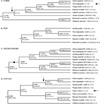Adrenal androgen production in catarrhine primates and the evolution of adrenarche
- PMID: 22271526
- PMCID: PMC4469270
- DOI: 10.1002/ajpa.22001
Adrenal androgen production in catarrhine primates and the evolution of adrenarche
Abstract
Adrenarche is a developmental event involving differentiation of the adrenal gland and production of adrenal androgens, and has been hypothesized to play a role in the extension of the preadolescent phase of human ontogeny. It remains unclear whether any nonhuman primate species shows a similar suite of endocrine, biochemical, and morphological changes as are encompassed by human adrenarche. Here, we report serum concentrations of the adrenal androgens dehydroepiandrosterone (DHEA) and dehydroepiandrosterone sulfate (DHEAS) measured in 698 cross-sectional and mixed longitudinal serum samples from catarrhine primates ranging from 0.6 to 47 years of age. DHEAS in Pan is most similar to that of humans in both age-related pattern and absolute levels, and a transient early increase appears to be present in Gorilla. DHEA levels are highest in Cercocebus, Cercopithecus, and Macaca. We also tested for evidence of adaptive evolution in six genes that code for proteins involved in DHEA/S synthesis. Our genetic analyses demonstrate the protein-coding regions of these genes are highly conserved among sampled primates. We describe a tandem gene duplication event probably mediated by a retrotransposon that resulted in two 3-β-hydroxysteroid dehydrogenase/Delta 5-Delta 4 genes (HSD3B1 and HSD3B2) with tissue specific functions in catarrhines. In humans, HSD3B2 is expressed primarily in the adrenals, ovary, and testis, while HSD3B1 is expressed in the placenta. Taken together, our findings suggest that while adrenarche has been suggested to be unique to hominoids, the evolutionary roots for this developmental stage are more ancient.
Copyright © 2012 Wiley Periodicals, Inc.
Figures






References
-
- Aiello LC, Wells JCK. Energetics and the evolution of the genus Homo. Annu Rev Anthropol. 2002;31:323–338.
-
- Arlt W, Martens JWM, Song M, Wang JT, Auchus RJ, Miller WL. Molecular evolution of adrenarche: structural and functional analysis of P450c17 from four primate species. Endocrinology. 2002;143:4665–4672. - PubMed
-
- Axelson M, Graham CE, Sjövall J. Identification and quantitation of steroids in sulfate fractions from plasma of pregnant chimpanzee, orangutan, and rhesus monkey. Endocrinology. 1984;114:337–344. - PubMed
-
- Bernstein RM, Leigh SR, Donovan SM, Monaco MH. Hormonal correlates of ontogeny in baboons (Papio hamadryas anubis) and mangabeys (Cercocebus atys) Am J Phys Anthro-pol. 2008;136:156–168. - PubMed
-
- Bogin B. Evolutionary hypotheses for human childhood. Ybk Phys Anthropol. 1997;40:63–89.
Publication types
MeSH terms
Substances
Grants and funding
LinkOut - more resources
Full Text Sources

